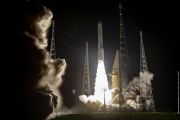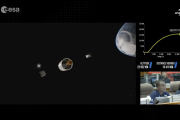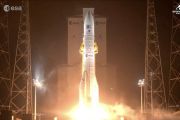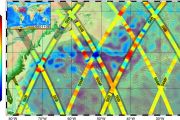
Copernical Team
Shaping the future of space telecommunications

ESA is inviting everyone working on space-enabled telecommunications – whether they are based in a large firm, a small start-up company or an established research institution – to help shape the future by joining a conference.
Lockheed Martin gets $1BN contract for sea-based hypersonic strike capability
 Lockheed Martin is partnering with the U.S. Navy to integrate hypersonic strike capability onto surface ships. The U.S. Navy awarded Lockheed Martin a contract worth more than $2 billion, if all options are exercised, to integrate the Conventional Prompt Strike (CPS) weapon system onto ZUMWALT-class guided missile destroyers (DDGs). CPS is a hypersonic boost-glide weapon system that enables long
Lockheed Martin is partnering with the U.S. Navy to integrate hypersonic strike capability onto surface ships. The U.S. Navy awarded Lockheed Martin a contract worth more than $2 billion, if all options are exercised, to integrate the Conventional Prompt Strike (CPS) weapon system onto ZUMWALT-class guided missile destroyers (DDGs). CPS is a hypersonic boost-glide weapon system that enables long Low power Ka-band transmitters on Earth observation satellites
 Axelspace Corporation has successfully developed a Ka-band radio for Earth observation microsatellites. The radio operates with less than half the power consumption of conventional radio. The collaborative research was jointly developed with Tokyo Institute of Technology (Tokyo Tech). With key collaborators Atsushi Shirane of the Laboratory for Future Interdisciplinary Research of Science and Pr
Axelspace Corporation has successfully developed a Ka-band radio for Earth observation microsatellites. The radio operates with less than half the power consumption of conventional radio. The collaborative research was jointly developed with Tokyo Institute of Technology (Tokyo Tech). With key collaborators Atsushi Shirane of the Laboratory for Future Interdisciplinary Research of Science and Pr New transmitter design for small satellite constellations improves signal transmission
 Today, there are many emerging applications for small satellite constellations, ranging from space-borne networks to environmental monitoring. However, small satellites have special needs when it comes to transmitter (TX) technology. For one, they have stringent limitations on power consumption as they draw energy from solar panels and cannot easily dissipate generated heat. Moreover, small sate
Today, there are many emerging applications for small satellite constellations, ranging from space-borne networks to environmental monitoring. However, small satellites have special needs when it comes to transmitter (TX) technology. For one, they have stringent limitations on power consumption as they draw energy from solar panels and cannot easily dissipate generated heat. Moreover, small sate Vast acquires launcher to accelerate growth
 To accelerate its mission to expand humanity across the solar system by developing long term human habitation in space, Vast has acquired space startup Launcher. Vast is building an artificial gravity station with many times the volume of the International Space Station in low Earth orbit. While steadily making progress toward this goal, Vast will be partnering with a global array of customers,
To accelerate its mission to expand humanity across the solar system by developing long term human habitation in space, Vast has acquired space startup Launcher. Vast is building an artificial gravity station with many times the volume of the International Space Station in low Earth orbit. While steadily making progress toward this goal, Vast will be partnering with a global array of customers, SpaceX Endeavour's crew arrive at KSC ahead of launch
 An international team of astronauts and scientists arrived at Kennedy Space Center in Florida on Tuesday, ahead of a six-month science mission to the International Space Station set to blast off on Sunday.
Crew-6 comprises two NASA astronauts, mission commander Stephen Bowen and pilot Warren Hoburg, along with mission specialists Sultan Alneyadi from the United Arab Emirates and Andrey
An international team of astronauts and scientists arrived at Kennedy Space Center in Florida on Tuesday, ahead of a six-month science mission to the International Space Station set to blast off on Sunday.
Crew-6 comprises two NASA astronauts, mission commander Stephen Bowen and pilot Warren Hoburg, along with mission specialists Sultan Alneyadi from the United Arab Emirates and Andrey When data show up late: Sols 3746-3748
 Today, I was heading for my computer when my colleagues went off to celebrate the end of the working week. Yes, that's right, planning started at 5 pm in my part of the world (the UK) today. That was one hour later than anticipated (and I would have missed all my colleagues going 'Have a good weekend!')
Why that late? Most days, we start an hour earlier, at 8 am in Pasadena California, not
Today, I was heading for my computer when my colleagues went off to celebrate the end of the working week. Yes, that's right, planning started at 5 pm in my part of the world (the UK) today. That was one hour later than anticipated (and I would have missed all my colleagues going 'Have a good weekend!')
Why that late? Most days, we start an hour earlier, at 8 am in Pasadena California, not Better tools needed to determine ancient life on Mars
 Current state-of-the-art instrumentation being sent to Mars to collect and analyze evidence of life might not be sensitive enough to make accurate assessments, according to a research team co-led by a Cornell University astronomer.
In a paper published in Nature Communications, visiting planetary scientist Alberto Fairen, and an international team of researchers, claim that ancient organic
Current state-of-the-art instrumentation being sent to Mars to collect and analyze evidence of life might not be sensitive enough to make accurate assessments, according to a research team co-led by a Cornell University astronomer.
In a paper published in Nature Communications, visiting planetary scientist Alberto Fairen, and an international team of researchers, claim that ancient organic Russian rescue mission for three space station astronauts set this week
 Russia's space agency Roscosmos' delayed rescue mission to send a Soyuz spacecraft to the International Space Station and bring three astronauts back to Earth is scheduled to lift off Thursday night EDT from the Baikonur Cosmodrome in Kazakhstan.
Russia originally had planned to send an unmanned Soyuz MS-23 spacecraft to the space station Feb. 14 to substitute for the docked Soyuz MS-22
Russia's space agency Roscosmos' delayed rescue mission to send a Soyuz spacecraft to the International Space Station and bring three astronauts back to Earth is scheduled to lift off Thursday night EDT from the Baikonur Cosmodrome in Kazakhstan.
Russia originally had planned to send an unmanned Soyuz MS-23 spacecraft to the space station Feb. 14 to substitute for the docked Soyuz MS-22 Radiation-resistant Ka-band radio for LEO constellation offers speeds Beyond 5G
 Axelspace Corporation Associate Professor Atsushi Shirane, and Professor Kenichi Okada and Assistant Professor Takashi Tomura of Tokyo Institute of Technology have successfully developed a radiation-resistant radio. The results of this research will be presented at ISSCC 2023, the world's largest international semiconductor-related conference, and Satellite 2023, scheduled to be held in the Unit
Axelspace Corporation Associate Professor Atsushi Shirane, and Professor Kenichi Okada and Assistant Professor Takashi Tomura of Tokyo Institute of Technology have successfully developed a radiation-resistant radio. The results of this research will be presented at ISSCC 2023, the world's largest international semiconductor-related conference, and Satellite 2023, scheduled to be held in the Unit 




























